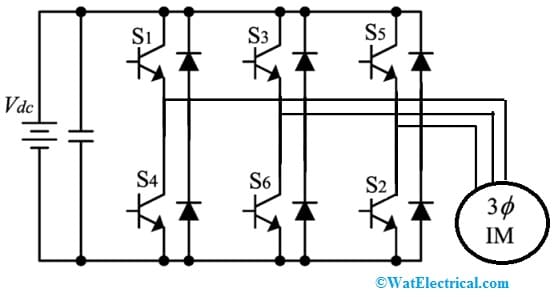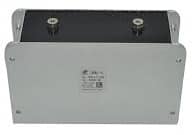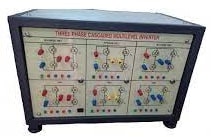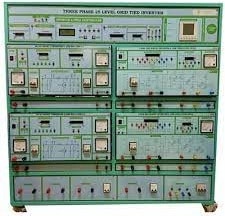An inverter is an electrical device mainly used to change current from DC to AC form. It is also known as a variable frequency drive (VFD) or AC Drive. The inverter is normally used in variable-frequency drive & high-power applications like HVDC power transmission and also these are responsible for controlling an electric motor’s torque & speed. These are categorized into two types depending on the source of power supply within the power circuit & the associated topology like single phase & three phases. This article discusses one of the types of inverter namely three-phase inverter –working & its applications.
What is Three Phase Inverter?
A DC -to -AC converter which uses a DC power source to generate 3-phase AC power is known as a 3-phase inverter. This type of inverter operates by using a power semiconductor switching topology. So, the gate signals within this type of topology are simply applied at 60-degree intervals in a correct series to the power switches to obtain the necessary 3-phase AC signal.
This inverter generates three-phase power using the PV modules & it can be simply connected to the 3-phase equipment/grid. Three-phase power includes 4 wires where three of them are active and one wire is neutral, so it is grounded at the switchboard. This power supply is very common in businesses, larger homes & older homes. It allows for less expensive, smaller wiring & low voltages.
These types of inverters are applicable in HVDC-based power transmission, variable frequency drive, AC motor drive, compensator, fixed VAR generator, fuel cell, UPS, high-frequency based induction heating & active harmonic filter applications.

Three Phase Inverter
Three-Phase Inverter Working Principle
A 3-phase inverter includes single-phase based 3-inverter switches where every switch in this inverter can be simply connected to the terminal of the load. The operation of these switches for a control system can be easily synchronized so each switch functions for a fundamental output waveform at every 60 degrees to make a line-to-line output waveform with 6 steps. So this output waveform has a zero voltage stage in between the two sections namely; positive square-wave & negative square wave. Whenever the carrier-based pulse width modulation technique is given to these waveforms, the fundamental waveform shape can be used so that the 3rd harmonic with its multiples can be canceled.
Three-Phase Inverter Circuit
The three-phase inverter circuit is shown below. This circuit is used to change the DC input current to the 3-phase AC output. A 3-phase inverter mainly includes three 1-phase inverter switches wherever every switch in this circuit is connected from three load terminals simultaneously.
Usually, to make a three-phase AC supply within this inverter, the 3 arms will wait from a 120-degree angle. The switching ratio utilized in this 3-phase inverter is 50% & also switching is done after each 60 degrees position. Here, S1 to S6 switches in this circuit will balance each other. So the 3 inverters through a single fuse are positioned within the same DC source. In a 3-phase inverter, the poling voltage equals the pole voltage in a half-phase inverter through a 1-phase. The single phase & 3-phase inverters mainly include two conduction modes like 120-degree & 180-degree which are discussed below.

Three Phase Inverter Circuit
180-Degree Conduction Mode
In 180 degrees conduction mode, every device is carried at 180 degrees and they are triggered at 60 degrees intervals. The 3-phase balanced load figure is shown below. The outputs such as X, Y & Z are simply allied to the three-phase delta connection of the load. For 0-60 degrees, S 1, S 5, & S 6 switches are within conduction mode. In this balanced load diagram, X & Z load terminals are simply connected at their positive points to the main source whereas terminal Y is connected at its negative point through the source.

Three Phase Balanced Load
Additionally, resistance like ‘R/2’ is available between the neutral & positive two ends whereas resistance ‘R’ is available between neutral & negative terminals.
In this type of mode, the load voltage is shown below.
VXN = V/3, VYN = −2V/3 and VZN = V/3
The line voltage can be given as;
VXY = VXN − VYN = V,
VYZ = VYN − VZN = −V,
VZX = VZN − VXN = 0
120-Degree Conduction Mode:
In 120-degree conduction mode, each device is within a 120-degree conductor position. So, it is appropriate for delta connection in the load, because it results in a waveform with six steps within a single phase. Thus at any specified time, this device will operate only each device will function at 120 only. The X & Y terminals on the load are connected through positive and negative terminals of the source and the ‘Z’ terminal on the load within the conductor is called the floating condition. Additionally, the phase voltage is equal to the load voltage which is given as;
The phase voltage is equivalent to the line voltage, so
VXY = V, VYZ = −V/2 and VZX = −V/2
Three-Phase Inverter Types
Three-phase inverters are available in different types and each type of this inverter has its own features and characteristics. Some common three-phase inverters are discussed below.
Voltage Source Inverter
A voltage Source Inverter (VSI) is one kind of inverter that changes a DC i/p voltage into an AC output voltage. This inverter is also called a VFI or voltage-fed inverter where at the input, the dc source negligible or small impedance has. This type of inverter is generally used in VFD (variable-frequency drive) systems for controlling the 3-phase motor speed. In this inverter, battery banks are used as a dc voltage source which includes multiple cells in the combinations of series & parallel. But in some cases, PV cells are also utilized as a dc source.

Voltage Source Inverter
Current-Source Inverter
A current Source Inverter is a type of Inverter used to change DC i/p current into AC current at a specified frequency. The o/p AC current frequency mainly depends on different switching devices’ frequencies like transistors, thyristors, etc. This inverter is also called a CFI (current-fed inverter) where the i/p current of this type of inverter will stay constant.

Current Source Inverter
This inverter includes a DC current source, filters & an AC load. This inverter is also available in two configurations like single-phase & three-phase. So, these inverters are perfect for different applications like synchronous motor starting, PF correction units, speed control of AC motors, induction heaters, plasma generators, UPS, lagging Var compensators, IM motors, etc.
Pulse-width Modulated Inverter
A PWM inverter or pulse-width modulated inverter is one kind of inverter that works by using the PWM technique to control the frequency & o/p voltage of the inverter. This inverter controls the IGBT very fast by switching ON & OFF. So, it is achievable to acquire nearly ideal sinusoidal voltage including extremely low harmonic distortion. This inverter is normally used in renewable energy systems & motor drives.

Pulse-width Modulated Inverter
Flying-capacitor Inverter
A flying-capacitor inverter is a three-phase inverter that utilizes a set of capacitors for storing & transmitting energy between the legs of the inverter. This type of inverter is a very efficient and economical solution for solar inverter-based applications. It is frequently used in high-power bases applications like charging stations for electric vehicles.

Flying-capacitor Type
Cascaded Multilevel Inverter
A cascaded multilevel inverter is a type of 3-phase inverter that utilizes various voltage levels to generate a stepped waveform. These inverters are mainly developed for electric utility applications. This inverter includes (M-1)/2 H-bridges where the dc voltage of every bridge is supported through its DC capacitor. The applications of this inverter mainly involve renewable energy systems & high-voltage power transmission systems.

Cascaded Multilevel Type
Hybrid Multilevel Inverter
The hybrid multilevel inverter is a type of three-phase inverter, used as an alternative in industrial applications for medium voltage & high power situations. This kind of inverter combines both current-source & voltage-source inverters elements. So it is normally utilized in high-power applications like electric vehicle charging stations.

Hybrid Multilevel Type
What are the Advantages of 3 Phase over Single Phase?
The advantages of three-phase over single-phase mainly include; constant power, higher rating, power transmission economics, three-phase induction motors superiority, self-starting, high efficiency, and power factor.
Why is 3-Phase Power Cheaper?
3-three phase power is more economical because it utilizes less conductor material for transmitting a specified amount of power.
What is 3 Phase Power Used For?
3-phase power is used for transmitting electricity to commercial buildings, industrial buildings & data centers, home appliances, etc.
Can I use a 3-Phase Breaker for Single-Phase?
A 3-phase breaker can be utilized on a single-phase system only if it is indicated by the markings.
What does 3 Phase Inverter Mean?
A three-phase inverter has three arms which are usually delayed with a 120° angle to produce a 3-phase AC supply by changing a DC supply.
Advantages
The advantages of three phase inverter include the following.
- A three-phase inverter transmits more power.
- It has high efficiency & stable voltage regulation.
- This type of inverter is more compatible with the electrical grid.
- These inverters are less affected by overvoltage events.
- This inverter provides a high range of output power.
Disadvantages
The disadvantages of three phase inverter include the following.
- Three-phase inverters are normally more expensive.
- These inverters operate with more complex electronics.
- These inverters’ design is more complex and very difficult to maintain & install.
- These are more expensive.
Applications
The applications of three phase inverter include the following.
- A three-phase inverter is mainly used for converting a DC input into an AC output.
- This inverter generates 3-phase AC power using a DC power source.
- It is used in high-power-based applications like HVDC power transmission.
- This type of inverter is utilized in high-power & variable-frequency drive-based applications like HVDC power transmission.
- This type of inverter is used in variable-speed induction motor drives.
Thus, this is an overview of three phase inverter – working, circuit, types, and applications. This inverter is mainly used for converting DC voltage to a 3-phase AC supply. So it is frequently used in variable-frequency drives & high-power-based applications like HVDC power transmission. Here is a question for you, what is a single-phase inverter?